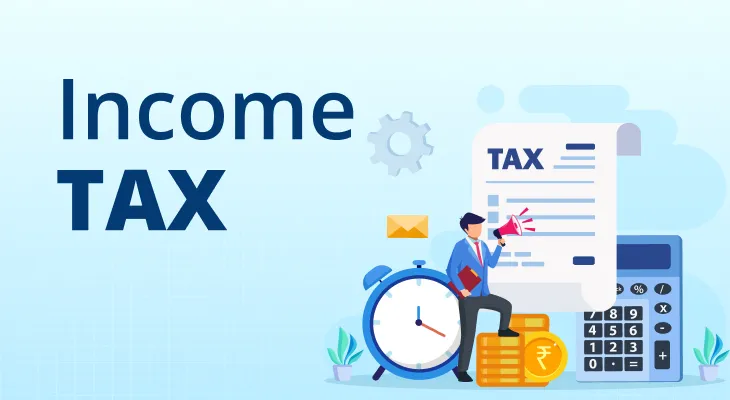
Income Tax Act, 1961
The Income Tax Act of 1961 (ITA) is a comprehensive legal structure that covers all elements related to income tax. It includes defining what counts as income, setting tax rates, and outlining how taxes are calculated. As an Indian taxpayer, you frequently engage with this Act, though it can be a bit complex to comprehend. In this blog, we'll explain how the Income Tax Act works for individuals, the rules it has, its connection with the Finance Act, and the impact of government notifications and circulars. We'll also explore the Finance Act in detail, discussing recent changes to income tax slabs. If you wish to know about the differences between the new and old tax rules, this guide is here to offer support.
Chapters of the Income Tax Act, 1961
The Income-tax Act, 1961 is divided into 23 chapters (including some sub-chapters), each addressing a specific aspect of taxation in India. These chapters provide the legal framework for everything from the basic charge of tax and exemptions to assessment procedures, appeals, penalties, and special provisions. The table below gives a simplified overview of each chapter along with a brief description of what it covers.
Chapter | What it covers |
|---|---|
(1) I. Preliminary | Short title, extent, commencement and key definitions that the rest of the Act relies on. |
(2) II. Basis of charge | Who is taxed and on what income, driven by residential status and scope of total income. |
(3) III. Incomes not forming part of total income | Statutory exemptions that are kept outside taxation. |
(4) IV. Computation of total income | Heads of income, set-up of how income is computed, and general rules of computation. |
(5) V. Income of other persons included in assessee’s total income | Clubbing provisions that pull specific incomes of others into the assessee’s tax base. |
(6) VI. Aggregation and set-off or carry-forward of losses | How different losses are adjusted against income across years. |
(6A) VI-A. Deductions in computing total income | Popular sections such as 80C, 80D to 80U that reduce taxable income. |
(6B) VI-B. Restriction on certain deductions in the case of companies | Deduction in respect of expenses incurred in connection with certain proceedings under the Act |
(7) VII. Incomes on which no income-tax is payable | Categories historically taxed at nil in specific circumstances; many provisions now inactive. |
(8) VIII. Rebates and reliefs | Reliefs that reduce tax payable in special situations, including timing-related relief. |
(9) IX. Double taxation relief | Treaty relief and unilateral relief to avoid the same income being taxed twice. |
(10) X. Special provisions to prevent avoidance | Transfer pricing, associated enterprises, specified domestic transactions and related anti-avoidance rules. |
(10A) X-A. General Anti-Avoidance Rules (GAAR) | Broad anti-avoidance framework to counter impermissible arrangements. |
(11) XI. Additional tax on undistributed profits of certain companies | Legacy chapter; provisions largely omitted but the chapter heading remains in the scheme. |
(12) XII. Determination of tax in certain special cases | Special rates or methods for specific incomes and assessees. |
(12A-12H) XII-A to XII-H (special sub-chapters) | Targeted regimes such as for certain non-residents, Minimum Alternate Tax (MAT) for companies, distribution taxes, tonnage tax and similar special provisions. |
(13) XIII. Income-tax authorities | CBDT and field authorities, their powers, jurisdiction and administrative set-up. |
(14) XIV. Procedure for assessment | Returns, enquiries, assessments, reassessments, rectification and related procedure. |
(14A) XIV-A. Special provision for avoiding repetitive appeals | Procedures to avoid repeated appeals regarding the same tax-related issue. |
(14B) XIV-B. Special procedure for assessment of search cases | Guidelines for assessing search cases. |
(15) XV. Liability in special cases | Liability when the assesses dies, dissolves, transfers business, or in representative capacities. |
(16) XVI. Special provisions applicable to firms | Special rules for firms and their partners, associations and bodies of individuals. |
(17) XVII. Collection and recovery of tax | Advance tax, TDS, TCS, interest for default or deferment, and recovery machinery. |
(18) XVIII. Relief respecting tax on dividends in certain cases | Defines the tax relief that can be provided on dividend income in specific cases. |
(19) XIX. Refunds | When refunds arise and the manner of granting them, including interest on refunds. |
(19A) XIX-A. Settlement of cases | Definitions, rules, and scope of settlement of different types of cases. |
(19AA) XIX-AA. Dispute resolution committee in certain cases | Defines the role and responsibilities of the Dispute Resolution Committee (DRC) for applicable cases. |
(19B) XIX-B. Advance rulings | Covers the scope and applicability of advance rulings. |
(20) XX. Appeals and revision | Appellate pathway through CIT(A), Tribunal, High Court and Supreme Court, plus revisionary powers. |
(20A) XX-A. Acquisition of immovable properties in certain cases of transfer to counteract evasion of tax | Regulations for acquisition of immovable properties in certain cases of transfer to prevent tax evasion. |
(20B) XX-B. Requirement as to mode of acceptance, payment or repayment in certain cases to counteract evasion of tax | Lays down the acceptable modes of payment or repayment in certain cases to prevent tax evasion. |
(20C) XX-C. Purchase by central government of immovable properties in certain cases of transfer | Lists the guidelines for purchase of immovable properties by the central government in certain cases of transfer. |
(21) XXI. Penalties | Civil penalties for specified failures and contraventions under the Act. |
(22) XXII. Offences and prosecutions | Criminal offences and prosecution procedures for wilful violations. |
(22B) XXII-B. Tax credit certificates | Defines and explains various tax credit certificates. |
(23) XXIII. Miscellaneous | Residual administrative matters, rule-making powers, and transitional provisions. |
Application of the Income Tax Act, 1961
The Income Tax Act is enforced across India through several supporting frameworks and provisions:
Income Tax Rules
The Central Board of Direct Taxes (CBDT) has laid down the Income Tax Rules to guide the administration and enforcement of direct taxes in the country. These rules outline the practical procedures for implementing the Act.
Finance Act
Each year, usually in the last week of February, the Ministry of Finance introduces a Finance Bill in Parliament. This bill proposes changes to the prevailing direct and indirect tax laws. Both the Lok Sabha and the Rajya Sabha can suggest revisions before passing it. Once approved by Parliament and receiving the President’s assent, it becomes the Finance Act.
Judicial Pronouncements
The Supreme Court plays a key role in resolving conflicts and interpreting tax provisions to ensure proper enforcement of the law. Its rulings are binding and applicable across the nation.
Government Notifications and Circulars
To ensure clarity and transparency, the government and the CBDT issue notifications and circulars. These help taxpayers and authorities interpret the provisions of the Act and understand any amendments.
Scope of Income Tax Act, 1961
The scope of taxation under the Act depends on the taxpayer’s residential status. The table below summarises when different types of income are taxable:
Income Type | Resident & Ordinarily Resident | Resident but Not Ordinarily Resident | Non-Resident |
|---|---|---|---|
Income earned or accrued in India | Taxable | Taxable | Taxable |
Income received or deemed received in India | Taxable | Taxable | Taxable |
Untaxed past foreign income brought into India | Non-taxable | Non-taxable | Non-taxable |
Income earned abroad from a business/profession in India | Taxable | Taxable | Non-taxable |
Income earned abroad from a business/profession outside India | Taxable | Non-taxable | Non-taxable |
Overview of the Finance Act
The Finance Act of 2023 has introduced several alterations to the Income Tax Act. Some of the noteworthy changes include:
The introduction of a fresh tax regime featuring reduced tax rates.
A rise in the standard deduction allowed for individuals with salaried income.
The introduction of a fresh tax deduction aimed at individuals who invest in long-term equity mutual funds.
An augmentation in the surcharge and cess on income tax. Income Tax Slabs and Tax Rates
Here is a glimpse of the new income tax slabs and tax rates for individuals who are not claiming deductions (new regime)
Tax Slabs | Income-tax Rates |
|---|---|
Up to ₹3 lakh | Nil |
₹3 lakh - 6 lakh | 5% |
₹6 lakh - 9 lakh | 10% |
₹9 lakh - 12 lakh | 15% |
Choosing between New and Old Tax Regimes
The Finance Act of 2023 has implemented a fresh tax regime distinguished by its lower tax rates. Within this new framework, the highest tax rate stands at 30%, as opposed to the former 35% prevalent in the old regime. However, opting for the new regime entails forfeiting certain deductions and exemptions. For those who prefer an alternative approach, the old tax regime remains available.
Understanding Permanent Account Number (PAN)
Comprising ten alphanumeric characters, the PAN number is vital for filing tax returns, conducting financial transactions, and even opening a bank account. Your PAN functions as a record of your financial transactions, highlighting its significance in maintaining financial transparency.
Conclusion
Amid the complex world of taxes, the Income Tax Act serves as a guiding light, showing the way toward responsible financial citizenship. With its complex set of rules and regulations, this act guides your money decisions, defines your tax duties, and contributes to the country's progress. The Income Tax Act is a complex law and taxpayers need to understand their tax obligations.
As you move through your financial journey, keep in mind to stay updated about the changes brought by the Finance Act and be aware of government notifications. Comprehending the complexities of the Income Tax Act allows you to navigate the financial realm while fulfilling the established regulations.
An Income Tax Calculator helps you estimate how much tax you need to pay based on your income, deductions, and exemptions. Use our Income Tax Calculator to understand your tax liability better and plan smarter to save more.
FAQ
The Income Tax Act of 1961 has how many sections?
The Income Tax Act of 1961 currently contains over 300 sections (including sub-sections), divided into various chapters. These sections cover all aspects of taxation in India, including income computation, exemptions, deductions, assessments, penalties, and appeals. The number can change over time due to amendments introduced in the Union Budget or Finance Acts.
What is the assessment year and financial year in Income Tax?
The financial year (FY) is the 12-month period in which you earn income, running from 1 April to 31 March. The assessment year (AY) is the year immediately following the FY, during which the income earned in the previous FY is assessed and taxed. For example, FY 2024–25 has AY 2025–26.
Who established the Income Tax Act in India?
The Income Tax Act, 1961 was enacted by the Government of India and came into force on 1 April 1962. It replaced the earlier Income Tax Act of 1922. The Act provides the framework for levying, collecting, and governing income tax in India and is administered by the Central Board of Direct Taxes (CBDT).
How many schedules are there in the Income Tax Act?
The Income Tax Act, 1961 contains 14 schedules. These schedules provide detailed rules, forms, and provisions that supplement specific sections of the Act. They cover aspects like rates of tax, deductions, exemptions, and computation methods. Amendments over time can add, modify, or remove schedules based on changing tax policies and requirements.
How does the Income Tax Act apply to different income sources?
The scope of the Income Tax Act extends across a wide range of income sources, including salaries, business profits, capital gains, and more. This comprehensive legislation covers individuals, corporations, and entities that generate income within the geographical boundaries of India.
What implications do the new and old tax regimes have on specific deductions?
Opting for a tax regime involves trade-offs. The New Tax Regime offers lower rates but limited deductions, while the Old Tax Regime features higher rates with a broader range of deductions.
What are the practical differences between a PAN and an Aadhaar Card Number?
Although both are unique identifiers, PAN is primarily for income tax-related transactions, whereas an Aadhaar card number has a broader scope and is issued by the government for various purposes, including social welfare schemes.
How can I stay updated about any changes introduced through the Finance Act?
Staying informed is essential. Regularly monitor government websites, trusted financial news outlets, and credible tax advisory sources for updates on amendments, circulars, and notifications. This ensures you're well-equipped to adapt to changes affecting your tax planning and compliance.
Can government notifications and circulars change the tax implications of an existing provision in the Income Tax Act?
Yes. Government notifications and circulars can provide additional guidance or interpretations on existing provisions of the Income Tax Act. These can impact the way a specific provision is applied or understood for practical purposes.


